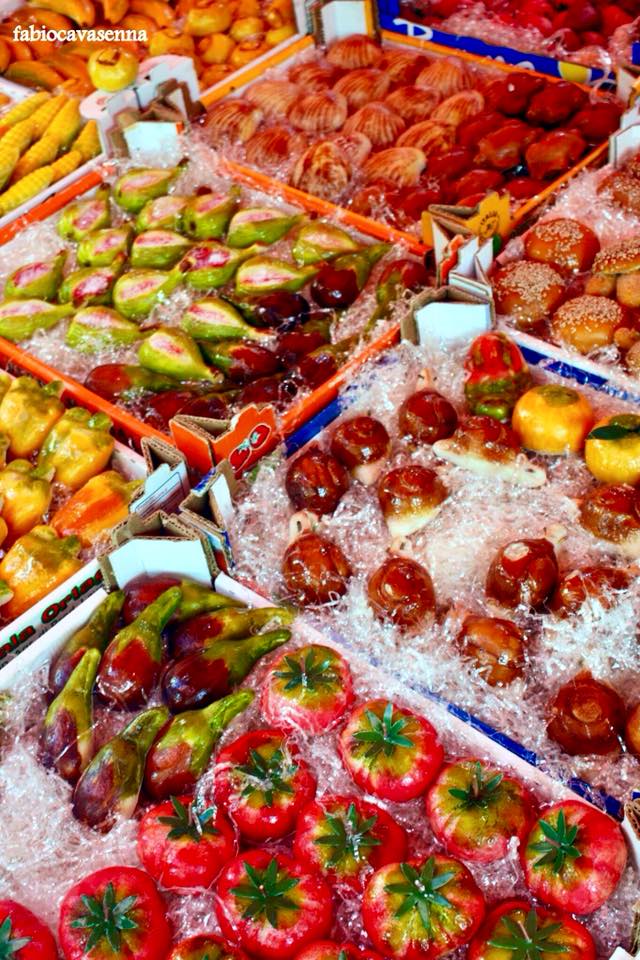Martorana fruit
Details
This fine almond paste with bright colours is an expression of great gastronomic creativity that perfectly imitates fruit and vegetables.
Arranged in wicker baskets or wooden crates, it cheers up the windows of all Sicilian pastry shops during the Day of the Dead on 2 November, but it is easy to find all year round.
We can be sure thatMartorana fruit was definitely invented by the nuns of the Monastery of the same name, founded in Palermo by the noblewoman Eloisa Martorana, but the history of these small works of culinary art is linked to numerous legends.
It is said that in the Late Middle Ages, the nuns received an illustrious visit from the Archbishop (or Emperor Charles V in 1535, according to another version). It was the beginning of November and, to make up for the lack of fruits that usually grew in the Monastery’s lush garden, the nuns had the idea of preparing desserts to offer their guest. They merrily decorated the trees of the famous garden with these gifts sculpted in the shape of fruit. The result was so surprising that since then, this fruit became the Monastery’s dessert par excellence, so much so that it took its name.
Legends aside, 500 years after its invention, Martorana fruit is still part of the Sicilian confectionery tradition, managing not only to delight palates but also to spark the imagination.
These exquisite marzipan sweets, perfectly reproducing vegetables and fruit, are a true expression of a great gastronomical creativity .
Gracefully placed in wicker baskets or in wooden boxes, they feature in almost every Sicilian pastry-shops windows , particularly during the Festival of the Dead, on November 2, but also throughout the whole year.
No doubt the so named Frutta Martorana was invented some time in the past by the nuns of The Martorana, a cloister, founded in Palermo by the noblewoman Eloisa Martorana, but the history of these small Sicilian culinary masterpieces is surrounded by some legends.
As the story goes, in the Middle Ages the nuns were waiting for an esteemed visitor: the Archbishop of Palermo (or the Emperor Carlo V, according to another version). As the trees of the convent’s lush garden were unusually empty – it was early November -, they decided to sculpt fruits from marzipan and hang them from the trees to impress their guest. The result was a great success and, since then, the Frutta Martorana has become the cloister ultimate sweet, to the extent that it is named after it.
Legends aside, after 500 years from its invention, this sweet is still present in the Sicilian confectionery tradition, tickling every palate and fantasy.
Let’s try to prepare it…
Frutta Martorana recipe (high difficulty)
Ingredients
For the almond paste:
- 500 g peeled and chopped almonds or almond flour
- 500 g sugar
- 125 ml water
- vanilla aroma
For decoration:
- food coloring
- gum arabic
- plastic leafs and fruit stalks
Preparation: Finely grind the peeled almonds or alternatively use the almond flour. In a pan warm the water and dissolve the sugar until it boils. Turn off and add vanilla aroma and almond flour. Stir continuously until you get a soft but solid dough that you can easily handle and remove from the pan. Pour the mixture onto your work surface, you’ll have slightly moistened and wait until it is lukewarm.
Start to knead until the dough becomes smooth and homogeneous and then model it into fruit and vegetables shapes. Let the little sweets dry for at least 20 hours, after that you can paint them with bright food coloring and polish with a finishing lacquer of gum Arabic. Complete your fruits with plastic leafs and fruit stalks to make them more realistic.
Share this content!
LOCATION
Difficulty
High
Duration of preparation
Ingredients
Peeled almonds or almond flour: 500 g
Sugar: 500 g
Water: 125ml
Vanillin: 1 sachet
Food colouring
Gum arabic
Stalks
Plastic leaves
Places
Seasons
Categories



